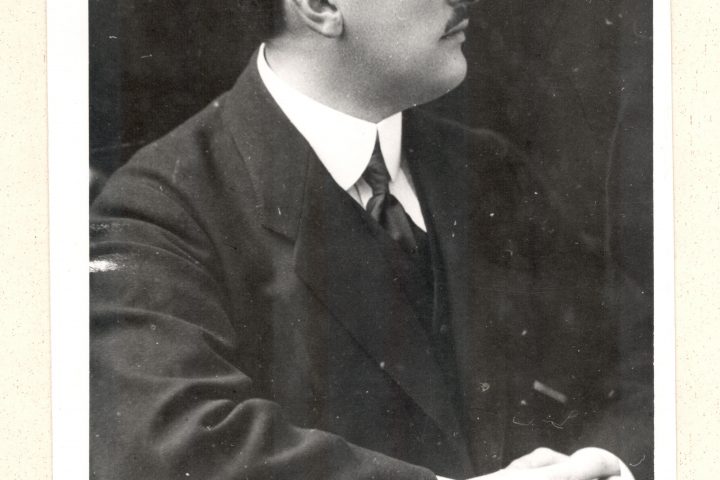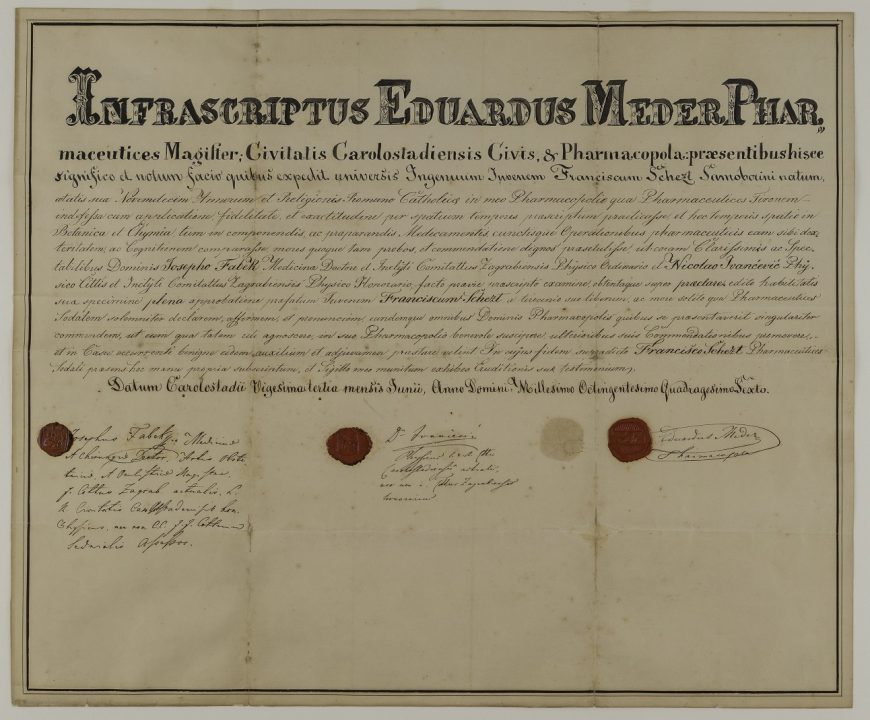Institutionalisation of the history of pharmacy and the making of the museum
(Excerpt from the text: Fatović-Ferenčić, Stella. From Pharmacies to Faculties – The Collection of Diplomas and Charters of the Croatian Museum of Medicine and Pharmacy, the Croatian Academy of Sciences and Arts (HAZU), as Attestation to the Development of Pharmaceutical Education in Croatia. // Diplomas and Charters from the Collection of the Croatian Museum of Medicine and Pharmacy. Zagreb: Croatian Academy of Sciences and Arts; Croatian Pharmaceutical Society, 2019. Catalogue of the exhibition, pp. 5-60.)
The ideas connected to the beginnings of institutionalisation and professionalisation of the history of pharmacy as a vocation in Croatia developed already at the end of the 19th century and occurred in the first decades of the 20th century, especially through the activities of professional societies, journals, as well as due to the efforts of some individuals. Although at the time the pharmaceutical class was powerfully polarised regarding its interests, the motivation connected to preserving the professional heritage was entirely unanimous and unique. Among the members of the Croatian Pharmaceutical Society was the already mentioned Stanislav Ilakovac, who in his pharmacy had a large library and a collection of almost all the world’s pharmacopoeia, and later others followed his example too. Furthermore, there were the first incentives to studying pharmacy as a scientific discipline, and a need to establish a pharmaceutical-historical institute and a pharmaceutical museum. An especially powerful élan in this respect took place inside the Croatian Pharmaceutical Society in the period between 1937 – 1940 with the suggestions about locating the future museum in the premises of the Croatian Pharmaceutical House.
As for collecting items for the museum, it was Artur Krajanski (1884 – 1941) who stood out the most in 1939. One of his greatest wishes was to become a lecturer and teach the History of Pharmacy at the Pharmaceutical Department of the Faculty of Philosophy. Although his request was denied, Krajanski continued with his activities in researching the history of pharmacy and the efforts to establish the Museum of the History of Pharmacy, as part of the Pharmaceutical Society. Unfortunately, this idea of his was not realised either.
An important step forward took place in the 1950s within the newly established Croatian Pharmaceutical Society and a lot of effort invested by pharmacist Hrvoje Tartalja, who graduated from the University of Zagreb in 1931. Due to his activities in the newly formed Pharmaceutical Society of Croatia, he was elected president several times and was also the co-founder and long-time editor and collaborator of the journal Farmaceutski glasnik. In 1950 the curriculum of the Faculty of Pharmacy introduced a new mandatory subject: The History of Pharmacy. Due to Tartalja’s endeavours, and with the help of the new Croatian Pharmaceutical Society, the Institute for the History of Pharmacy was founded on 19 April 1952. It established its collection by taking over the items which were kept on the premises of the Pharmaceutical Society, those stored in the Museum of Arts and Crafts and by purchasing objects from various pharmacies. In 1960 the Institute of the History of Pharmacy integrated with other such institutes and collections of the Physicians’ Assembly, as part of the Institute for the History of Natural, Mathematical and Medical Sciences at the Yugoslav Academy of Sciences and Arts. This collection became the responsibility of the Croatian Museum of Medicine and Pharmacy upon its founding in 2014. The museum holdings, among other important collections, highlight the preserved diplomas and charters of Croatian pharmacists as valuable historiographic and museum material.



